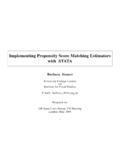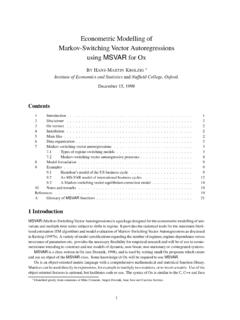Transcription of EC 823: Applied Econometrics - Boston College
1 ARCH and MGARCH modelsChristopher F BaumEC 823: Applied EconometricsBoston College , Spring 2014 Christopher F Baum (BC / DIW)ARCH and MGARCH modelsBoston College , Spring 20141 / 38 ARCH modelsSingle-equation modelsARCH modelsHeteroskedasticity can occur in time series models, just as it may in across-sectional context. It has the same consequences: the OLS pointestimates are unbiased and consistent, but their standard errors will beinconsistent, as will hypothesis test statistics and confidence may prevent that loss of consistency by usingheteroskedasticity-robust standard errors. The Newey West or HACstandard errors available fromneweyin the OLS context orivreg2inthe instrumental variables context will be robust to arbitraryheteroskedasticity in the error process as well as serial F Baum (BC / DIW)ARCH and MGARCH modelsBoston College , Spring 20142 / 38 ARCH modelsSingle-equation modelsThe most common model of heteroskedasticity employed in the timeseries context is that ofautoregressive conditional heteroskedasticity,or ARCH.
2 As proposed by Nobel laureate Robert Engle in 1982, anARCH model starts from the premise that we have a static regressionmodelyt= 0+ 1zt+utand all of the Gauss Markov assumptions hold, so that the OLSestimators are BLUE. This implies thatVar(ut|Z)is constant. But evenwhen this unconditional variance ofutis constant, we may have timevariation in theconditional varianceofut:E(u2t|ut 1,ut 2,..) =E(u2t|ut 1) = 0+ 1u2t 1so that the conditional variance ofutis a linear function of the squaredvalue of its F Baum (BC / DIW)ARCH and MGARCH modelsBoston College , Spring 20143 / 38 ARCH modelsSingle-equation modelsIf the originalutprocess is serially uncorrelated, the varianceconditioned on a single lag is identical to that conditioned on the entirehistory of the series. We can rewrite this asht= 0+ 1u2t 1whereut= htvt,vt (0,1). This formulation represents theARCH(1) model, in which a single laggedu2enters the ARCH equation.
3 A higher-order ARCH equation would include additional lagsofu2. To ensure a positive variance, 0>0 and 1>0. When 1>0,the squared errors are positively serially correlated even though theutthemselves are F Baum (BC / DIW)ARCH and MGARCH modelsBoston College , Spring 20144 / 38 ARCH modelsSingle-equation modelsSince we could estimate this equation and derive OLSbwhich areBLUE, why should we be concerned about ARCH? First, we couldderive consistent estimates ofbwhich are asymptotically moreefficient than the OLS estimates, since the ARCH structure is nolonger a linear , the dynamics of the conditional variance are important inmany contexts: particularly financial models, in which movements involatility are themselves important. Many researchers have found ARCH effects" in higher-frequency financial data, and to the extent towhich they are present, we may want to take advantage of them. Wemay test for the existence of ARCH effects in the residuals of a timeseries regression by using the commandestat archlm.
4 The nullhypothesis is that of no ARCH effects; a rejection of the null implies theexistence of significant ARCH effects, or persistence in the F Baum (BC / DIW)ARCH and MGARCH modelsBoston College , Spring 20145 / 38 ARCH modelsSingle-equation modelsThe ARCH model is inherently nonlinear. If we assume that theutaredistributed Normally, we may use a maximum likelihood proceduresuch as that implemented in Stata sarchcommand to jointly estimateits mean and conditional variance ARCH model has been extended to a generalized form which hasproven to be much more appropriate in many contexts. In the simplestexample, we may writeht= 0+ 1u2t 1+ 1ht 1which is known as the GARCH(1,1) model since it involves a single lagof both the ARCH term and the conditional variance term. We mustimpose the additional constraint that 1>0 to ensure a F Baum (BC / DIW)ARCH and MGARCH modelsBoston College , Spring 20146 / 38 ARCH modelsSingle-equation modelsWe may also have a so-called ARCH-in-mean model, in which thehtterm itself enters the regression equation.
5 This sort of model would berelevant if we had a theory that suggests that the level of a variablemight depend on its variance, which may be very plausible in financialmarkets contexts or in terms of, say, inflation, where we often presumethat the level of inflation may be linked to inflation volatility. In suchinstances we may want to specify a ARCH- or GARCH-in-mean modeland consider interactions of this sort in the conditional mean (level) F Baum (BC / DIW)ARCH and MGARCH modelsBoston College , Spring 20147 / 38 ARCH modelsAlternative GARCH specificationsAlternative GARCH specificationsA huge literature on alternative GARCH specifications exists; many ofthese models are preprogrammed in Stata sarchcommand, andreferences for their analytical derivation are given in the Stata of particular interest is Nelson s (1991) exponential GARCH, orEGARCH. He proposed:loght= + j=1 j( t j E t j + t j)which is then parameterized as a rational lag of two finite orderpolynomials, just as in Bollerslev s F Baum (BC / DIW)ARCH and MGARCH modelsBoston College , Spring 20148 / 38 ARCH modelsAlternative GARCH specificationsAdvantages of the EGARCH specification include the positive nature ofhtirregardless of the estimated parameters, and the asymmetricnature of the impact of innovations: with 6=0,a positive shock willhave a different effect on volatility than will a negative shock, mirroringfindings in equity market research about the impact of bad news and good news on market volatility.
6 For instance, a simple EGARCH(1,1)model will provide a variance equation such asloght= 0+ 1zt 1+ 2 zt 1 2/ + 3loght 1wherezt= t/ t, which is distributed asN(0,1).Christopher F Baum (BC / DIW)ARCH and MGARCH modelsBoston College , Spring 20149 / 38 ARCH modelsAlternative GARCH specificationsNelson s model is only one of several extensions of GARCH that allowfor asymmetry, or consider nonlinearities in the process generating theconditional variance: for instance, the threshold ARCH model ofZakoian (1990) and the Glosten et al. model (1993).Christopher F Baum (BC / DIW)ARCH and MGARCH modelsBoston College , Spring 201410 / 38 ARCH modelsImplementationStata 12 provides a suite of commands to estimate time series modelsin the ARCH (Autoregressive Conditional Heteroskedasticity) commandarchis used to estimate single-equation models. Itsoptions allow the specification of over a dozen models from theliterature, including ARCH, GARCH, ARCH-in-mean, GARCH withARMA errors, EGARCH (exponential GARCH), TARCH (thresholdARCH), GJR (Glosten et al.)
7 , 1993), SAARCH (simple asymmetricARCH), PARCH (power ARCH), NARCH (nonlinear ARCH), APARCH(asymmetric power ARCH) and NPARCH (nonlinear power ARCH).Errors may be specified as Gaussian,t, or GED (generalized errordistribution).Christopher F Baum (BC / DIW)ARCH and MGARCH modelsBoston College , Spring 201411 / 38 ARCH modelsImplementationTo estimate an ARCH model, you give thearchvarnamecommand,followed by (optionally) the independent variables in the meanequation and the options indicating the type of model. For instance, tofit a GARCH(1,1) to the mean regression ofcpionwage,arch cpi wage, arch(1) garch(1)It is important to note that a GARCH(2,1) model would be specifiedwith the optionarch(1/2). If the option was given asarch(2), onlythe second-order term would be included in the conditional F Baum (BC / DIW)ARCH and MGARCH modelsBoston College , Spring 201412 / 38 ARCH modelsImplementationA test for ARCH effects in a linear regression can be conducted withtheestat archlmcommand.
8 Using Stata suratedataset ofmonthly unemployment rates for several US states:. webuse urates, clear. qui reg estat archlm, lags(3)LM test for autoregressive conditional heteroskedasticity (ARCH)lags(p)chi2 df Prob > 3 : no ARCH : ARCH(p) disturbanceThe LM test indicates the presence of significant ARCH F Baum (BC / DIW)ARCH and MGARCH modelsBoston College , Spring 201413 / 38 ARCH modelsImplementationWe estimate a GARCH(1,1) model:. arch , arch(1) garch(1) nolog vsquishARCH family regressionSample: 1978m3 - 2003m12 Number of obs = 310 Distribution: Gaussian Wald chi2(1) = likelihood = Prob > chi2 = Std. Err. z P>|z| [95% Conf. Interval] .0694996 .076736 ..0085746.
9 0675544 .0605219 ..0923551 .5328415 ..0016481 .0060868 Following estimation, we may usepredictwith thevarianceoptionto produce the conditional variance F Baum (BC / DIW)ARCH and MGARCH modelsBoston College , Spring 201414 / 38 ARCH variance, one-step1980m11985m11990m11995m12000m120 05m1 MonthConditional variance from GARCH(1,1)Christopher F Baum (BC / DIW)ARCH and MGARCH modelsBoston College , Spring 201415 / 38 ARCH modelsImplementationWe may also fit a model with additional variables in the mean equation:. arch , arch(1) garch(1) nolog vsquishARCH family regressionSample: 1978m3 - 2003m12 Number of obs = 310 Distribution: Gaussian Wald chi2(3) = likelihood = Prob > chi2 = Std. Err. z P>|z| [95% Conf. Interval].
10 0723994 .004097 ..047494 .0820727 ..0757688 ..0087075 ..0712808 .0230064 ..1388493 .4071896 ..0026923 .0094832 Christopher F Baum (BC / DIW)ARCH and MGARCH modelsBoston College , Spring 201416 / 38 ARCH modelsImplementationFollowing estimation, we may test hypotheses on the coefficients of theconditional variance equation: for instance, that they sum to unity,indicating integrated GARCH:. test [ARCH] + [ARCH] == 1( 1) [ARCH] + [ARCH] = 1chi2( 1) = > chi2 = this case, that hypothesis cannot be rejected at 90%.Christopher F Baum (BC / DIW)ARCH and MGARCH modelsBoston College , Spring 201417 / 38 ARCH modelsMultiple-equation modelsMultiple-equation GARCH modelsMultivariate GARCH models allow the conditional covariance matrix ofthe dependent variables to follow a flexible dynamic structure and allowthe conditional mean to follow a vector autoregressive (VAR) general MGARCH model can be written asyt=Cxt+ t t=H1/2t twhereytis a m-vector of dependent variables,Cis am kparametermatrix,xtis a k-vector of explanatory variables, possibly including lagsofyt,H1/2tis the Cholesky factor of the time-varying conditionalcovariance matrixHt, and tis a m-vector of zero-mean, F Baum (BC / DIW)ARCH and MGARCH modelsBoston College , Spring 201418 / 38 ARCH modelsMultiple-equation modelsIn this general framework,Htis a matrix generalization of univariateGARCH models.









